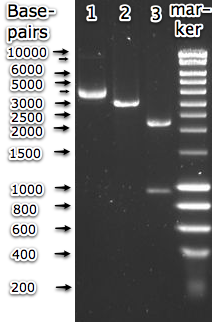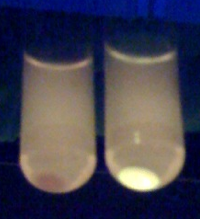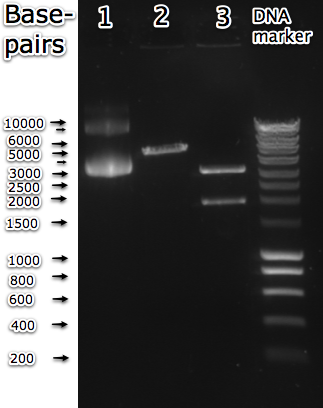Team:TUDelft/SDP Results
From 2009.igem.org
Tim Weenink (Talk | contribs) (→Experimental results) |
Tim Weenink (Talk | contribs) (→Experimental results) |
||
| Line 28: | Line 28: | ||
[[Image:BBa_K175044_restriction.png|thumb|right| Gel electrophoresis of <partinfo>BBa_K175044</partinfo> in pSB1AK3 backbone. Lane 1: undigested (supercoiled) plasmid. Lane 2: PstI digested part, expected size = 5095bp. Lane 3: PstI and I-SceI restricted part, expected band lenghts are 3204 and 1891bp. Expected lenghts correspond to the bands observed in the gel.]] | [[Image:BBa_K175044_restriction.png|thumb|right| Gel electrophoresis of <partinfo>BBa_K175044</partinfo> in pSB1AK3 backbone. Lane 1: undigested (supercoiled) plasmid. Lane 2: PstI digested part, expected size = 5095bp. Lane 3: PstI and I-SceI restricted part, expected band lenghts are 3204 and 1891bp. Expected lenghts correspond to the bands observed in the gel.]] | ||
| + | |||
| + | |||
| + | |||
| + | |||
| + | |||
Secondly, the part was digested with PstI alone and with PstI and I-SceI. The lenght of the entire biobrick was expected to be 5095bp. The second lane in the adjacent image shows that the observed length corresponds to the predicted length. The part was also digested with PstI and I-SceI, theoretically resulting in two bands of 3204 and 1891bp. The resulting bands in lane 3 of the same figure show that these also correspond well. | Secondly, the part was digested with PstI alone and with PstI and I-SceI. The lenght of the entire biobrick was expected to be 5095bp. The second lane in the adjacent image shows that the observed length corresponds to the predicted length. The part was also digested with PstI and I-SceI, theoretically resulting in two bands of 3204 and 1891bp. The resulting bands in lane 3 of the same figure show that these also correspond well. | ||
| Line 47: | Line 52: | ||
=='''I-SceI homing endonuclease'''== | =='''I-SceI homing endonuclease'''== | ||
| - | After successful construction of the restriction site with reportergene, the actual protein was added to the construct. The IPTG inducible part (<partinfo>BBa_K142205</partinfo>) made by the 2008 ETH Zurich team was used for this. However, after having it sequenced, the part appeared to be a medium constitutive T4 ligase generator (<partinfo>BBa_K142207</partinfo>), made by the same team. To rule out a mistake by the registry, the part was requested again. A new batch was transformed and sent to us. It was grown up, isolated and restricted with EcoRI and PstI, to obtain insert length. It was exactly as long as the first batch (~1700bp), which corresponds to the expected length of <partinfo>BBa_K142207</partinfo> (1668bp), and is significantly longer than the expected length of 1114bp. | + | After successful construction of the restriction site with reportergene, the actual protein was added to the construct. The IPTG inducible part (<partinfo>BBa_K142205</partinfo>) made by the 2008 ETH Zurich team was used for this. However, after having it sequenced, the part appeared to be a medium constitutive T4 ligase generator (<partinfo>BBa_K142207</partinfo>), made by the same team. To rule out a mistake by the registry, the part was requested again. A new batch was transformed and sent to us. It was grown up, isolated and restricted with EcoRI and PstI, to obtain insert length. It was exactly as long as the first batch (~1700bp), which corresponds to the expected length of <partinfo>BBa_K142207</partinfo> (1668bp), and is significantly longer than the expected length of 1114bp. These findings were entered into the registry as a user review of <partinfo>BBa_K142205</partinfo>. |
| + | As a workaround, a twin of what was supposed to be <partinfo>BBa_K142205</partinfo> was constructed, using <partinfo>BBa_K142202</partinfo>. The sequence of the resulting part (<partinfo>BBa_K175041</partinfo>) was confirmed, as shown in the sequence analysis section of the parts page. Thereby the sequence of <partinfo>BBa_K142202</partinfo> was indirectly confirmed. | ||
Revision as of 22:44, 21 October 2009
Experimental results
The experimental results for the Self Destructive Plasmid are detailed below. In the process of constructing it, we deviated from the cloning strategy after proving that it didn't work as expected.
I-SceI restriction site
Construction of the I-SceI homing endonuclease restriction site was done by primer synthesis. Primers were annealed and ligated into a pSB1AK3 backbone (3189bp without the insert). Together with the 30bp recognition sequence (shown below) this gave a 3219 bp part. The sites where cleavage of the DNA backbone occurs are indicated with ^.
5' A G T T A C G C T A G G G A T A A^C A G G G T A A T A T A G 3'
3' T C A A T G C G A T C C C^T A T T G T C C C A T T A T A T C 5'
The resulting biobrick () was successfully sequenced and tested for functionality. Sequencing results can be found on the part page. Functionality was assessed using commercially available I-SceI restriciton enzyme. The plasmid was purified and subjected to a digestion with BglI alone and BglI plus I-SceI. The latter would theoretically result in two fragments of 2275 and 944bp.
The results in the adjecent image show that the digestion indeed results in the expected band pattern. This shows that the restriction site works as expected.
As shown in the cloning strategy, the restriction site was cloned inbetween the promoter and the RBS, resulting in , which was expected not to influence transcription. However, when a culture containing this biobrick was induced with anhydrotetracyclin (aTc), no fluorescence was observed. This led to a modification of the cloning strategy.
A simpler part was constructed (), which only contained the restriction site in front of the aTc inducible GFP-LVA generator.
This part was successfully sequenced and shown to work. Firstly, aTc fluorescence induction worked, as shown in the following image.
Secondly, the part was digested with PstI alone and with PstI and I-SceI. The lenght of the entire biobrick was expected to be 5095bp. The second lane in the adjacent image shows that the observed length corresponds to the predicted length. The part was also digested with PstI and I-SceI, theoretically resulting in two bands of 3204 and 1891bp. The resulting bands in lane 3 of the same figure show that these also correspond well.
Thirdly, the sequence was confirmed by sequencing the part in forward and reverse direction.
I-SceI homing endonuclease
After successful construction of the restriction site with reportergene, the actual protein was added to the construct. The IPTG inducible part () made by the 2008 ETH Zurich team was used for this. However, after having it sequenced, the part appeared to be a medium constitutive T4 ligase generator (), made by the same team. To rule out a mistake by the registry, the part was requested again. A new batch was transformed and sent to us. It was grown up, isolated and restricted with EcoRI and PstI, to obtain insert length. It was exactly as long as the first batch (~1700bp), which corresponds to the expected length of (1668bp), and is significantly longer than the expected length of 1114bp. These findings were entered into the registry as a user review of .
As a workaround, a twin of what was supposed to be was constructed, using . The sequence of the resulting part () was confirmed, as shown in the sequence analysis section of the parts page. Thereby the sequence of was indirectly confirmed.
Integration
Experimental results
Experimental results
'Experimental results'
Experimental results
Experimental results
Experimental results
'Experimental results'
Experimental results
Experimental results
Experimental results
'Experimental results'
Experimental results
 "
"











